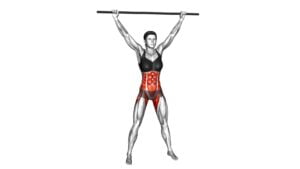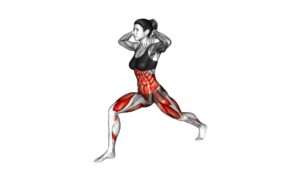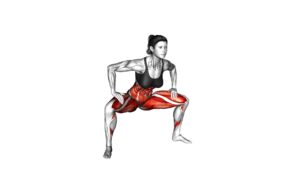Standing Twist Stretch (female) – Video Exercise Guide & Tips

Are you looking for a quick and effective way to stretch your body? Look no further!
Watch This Exercise Video
In this video exercise guide, we will walk you through the Standing Twist Stretch. This stretch is perfect for women of all fitness levels and can be easily incorporated into your daily routine.
By following our expert tips and techniques, you'll be able to improve your flexibility and promote better overall wellness.
So let's get started on this journey to a healthier you!
Key Takeaways
- Standing Twist Stretch increases flexibility and range of motion in obliques, lower back muscles, and hips.
- It helps improve posture and spinal alignment.
- The stretch enhances blood circulation and oxygen flow to the muscles.
- Standing Twist Stretch reduces muscle tension and stiffness.
Benefits of the Standing Twist Stretch
Experience the numerous benefits of the Standing Twist Stretch to improve flexibility and posture. This simple yet effective stretch targets the muscles in your core and helps to increase your overall flexibility. By incorporating the Standing Twist Stretch into your regular exercise routine, you can improve your range of motion and prevent muscle tightness and imbalances.
One of the main benefits of the Standing Twist Stretch is that it helps to improve flexibility. As you twist your torso, you engage the muscles in your lower back, hips, and obliques. This helps to stretch and lengthen these muscles, increasing your overall flexibility. By improving flexibility, you can enhance your performance in other exercises and activities, as well as reduce the risk of injuries.
In addition to improving flexibility, the Standing Twist Stretch also helps to increase core strength. As you twist, you engage your core muscles, including your abdominals and back muscles. This helps to strengthen these muscles, leading to improved posture and stability. A strong core is essential for maintaining proper form during exercise and everyday activities.
Incorporating the Standing Twist Stretch into your routine can have numerous benefits, including improved flexibility and increased core strength. By regularly performing this stretch, you can enhance your overall fitness and well-being.
Proper Technique for the Standing Twist Stretch
To perform the Standing Twist Stretch correctly, regularly incorporate this exercise into your routine. Follow these steps to ensure proper technique:
- Warm up exercises for the standing twist stretch: Before attempting this stretch, it's important to warm up your body to prevent injury. Consider incorporating dynamic movements such as arm circles, shoulder rolls, and torso twists to prepare your muscles for the stretch.
- Variations of the standing twist stretch for improved flexibility: Once you have mastered the basic standing twist stretch, you can explore variations to enhance your flexibility. Try adding a slight bend to your knees or reaching your opposite hand towards the sky as you twist. These variations will engage different muscles and deepen the stretch.
- Maintain proper form: Stand with your feet shoulder-width apart and keep your spine tall. As you twist, engage your core muscles and exhale deeply. Avoid jerky or rapid movements, and instead focus on a slow and controlled rotation of your torso.
By incorporating warm-up exercises and exploring variations, you can maximize the benefits of the standing twist stretch.
Now, let's move on to the next section to learn about modifications for different fitness levels.
Modifications for Different Fitness Levels
For different fitness levels, you can make modifications to the standing twist stretch. Whether you're a beginner or an advanced exerciser, there are options to tailor this stretch to your needs.
For beginners, it's important to start with a smaller range of motion. Instead of twisting your torso as far as possible, begin by gently rotating your upper body from side to side. Focus on maintaining proper form and breathing deeply throughout the movement. As you become more comfortable and flexible, you can gradually increase the intensity by twisting a little further each time.
On the other hand, advanced modifications of the standing twist stretch can be incorporated for those with greater flexibility and strength. To challenge yourself, try holding a light dumbbell or medicine ball in your hands while twisting. This added resistance will engage your core muscles even more and increase the difficulty of the exercise.
Remember, it's important to listen to your body and only perform modifications that are appropriate for your fitness level. Push yourself, but always within your limits to avoid injury.
Now that you know how to modify the standing twist stretch for different fitness levels, let's move on to the next section and discuss common mistakes to avoid.
Common Mistakes to Avoid
As you continue with the standing twist stretch, it's important to be aware of common mistakes to avoid. Here are three common misconceptions about the standing twist stretch and variations of the exercise for specific muscle groups:
- Avoid using momentum: One common mistake is relying on momentum to perform the standing twist stretch. Instead, focus on engaging your core muscles and using controlled movements. This will ensure that you're effectively stretching your muscles and reducing the risk of injury.
- Don't over-twist your body: Another common misconception is that the more you twist your body, the better the stretch. However, over-twisting can strain your back and lead to discomfort. Instead, aim for a gentle twist that feels comfortable and allows for a gradual increase in flexibility over time.
- Adapt the stretch for different muscle groups: The standing twist stretch can be modified to target specific muscle groups. For example, to focus on your obliques, you can place one hand on your hip while twisting to the opposite side. To target your lower back, you can place both hands behind your head and twist from your waist. Experiment with different variations to find what works best for you.
Tips for Incorporating the Standing Twist Stretch Into Your Fitness Routine
To incorporate the standing twist stretch into your fitness routine, start by finding a comfortable standing position. Stand with your feet shoulder-width apart and engage your core muscles. Keep your spine straight and relax your shoulders. From this position, you can perform various standing twist variations to target different muscles and increase the benefits of twisting exercises.
One variation is the standing twist with arms extended. Begin by interlocking your fingers and extending your arms straight out in front of you. As you twist to the right, keep your arms parallel to the floor and your gaze forward. Hold the stretch for a few seconds, then repeat on the other side.
Another variation is the standing twist with a side bend. Start by placing your right hand on your hip and extending your left arm overhead. As you twist to the right, lean your upper body towards the left side. Feel the stretch along your side and hold for a few seconds before switching sides.
Incorporating standing twist stretches into your fitness routine can have several benefits. Twisting exercises help improve spinal mobility and flexibility, strengthen the core muscles, and promote better posture. They also engage the obliques, lower back muscles, and hips, leading to a more balanced and toned physique.
Remember to warm up your muscles before performing standing twist stretches and listen to your body. If you experience any pain or discomfort, modify the exercise or consult a fitness professional for guidance.
Frequently Asked Questions
How Many Repetitions of the Standing Twist Stretch Should I Do?
To get the most out of the standing twist stretch, it's important to know how many repetitions to do.
The standing twist stretch benefits your core and improves flexibility. To properly perform the exercise, stand with your feet shoulder-width apart, twist your upper body to one side, and hold for a few seconds. Then, repeat on the other side.
Start with 5-10 repetitions and gradually increase as you feel more comfortable and flexible.
Can the Standing Twist Stretch Help With Reducing Lower Back Pain?
The standing twist stretch is a great exercise for reducing lower back pain. By incorporating this stretch into your routine, you can experience the benefits of increased flexibility and improved posture.
To perform the standing twist stretch, simply stand with your feet shoulder-width apart, twist your torso to the right, and hold for a few seconds before repeating on the left side.
This exercise targets the muscles in your lower back, providing relief and alleviating discomfort.
Is the Standing Twist Stretch Safe for Pregnant Women?
The standing twist stretch is a common exercise for stretching and relieving tension in the lower back.
However, when it comes to pregnancy, it's important to take precautions. The standing twist stretch may not be safe for pregnant women, as it involves twisting the torso and could potentially strain the abdominal muscles.
It's recommended to consult with a healthcare professional for modifications or alternative exercises that are safe and beneficial during pregnancy.
Can I Perform the Standing Twist Stretch if I Have a Knee Injury?
If you have a knee injury, it's best to avoid the standing twist stretch. This exercise puts pressure on the knees and could worsen your injury.
Instead, try modifying the standing twist by keeping your feet hip-width apart and only rotating your upper body gently. This will still stretch your torso without straining your knees.
Additionally, there are alternative knee-friendly stretches you can try, such as seated twists or gentle leg stretches.
Does the Standing Twist Stretch Help Improve Digestion?
The standing twist stretch is great for improving digestion. By incorporating this stretch into your daily exercise routine, you can reap the benefits of increased overall flexibility.
This stretch helps to stimulate the digestive system and can relieve bloating and discomfort. It's a simple but effective way to support your digestive health and enhance your overall well-being.
Conclusion
Incorporating the standing twist stretch into your fitness routine can provide numerous benefits. This exercise is known for improving flexibility and relieving tension in the spine. To ensure maximum effectiveness, it is important to follow the proper technique and make modifications based on your fitness level. Additionally, it is crucial to avoid common mistakes and remember to breathe deeply throughout the exercise. By adding the standing twist stretch to your routine, you can enhance your overall fitness and well-being.

Author
Years ago, the spark of my life’s passion ignited in my mind the moment I stepped into the local gym for the first time. The inaugural bead of perspiration, the initial endeavor, the very first surge of endorphins, and a sense of pride that washed over me post-workout marked the beginning of my deep-seated interest in strength sports, fitness, and sports nutrition. This very curiosity blossomed rapidly into a profound fascination, propelling me to earn a Master’s degree in Physical Education from the Academy of Physical Education in Krakow, followed by a Sports Manager diploma from the Jagiellonian University. My journey of growth led me to gain more specialized qualifications, such as being a certified personal trainer with a focus on sports dietetics, a lifeguard, and an instructor for wellness and corrective gymnastics. Theoretical knowledge paired seamlessly with practical experience, reinforcing my belief that the transformation of individuals under my guidance was also a reflection of my personal growth. This belief holds true even today. Each day, I strive to push the boundaries and explore new realms. These realms gently elevate me to greater heights. The unique combination of passion for my field and the continuous quest for growth fuels my drive to break new ground.



